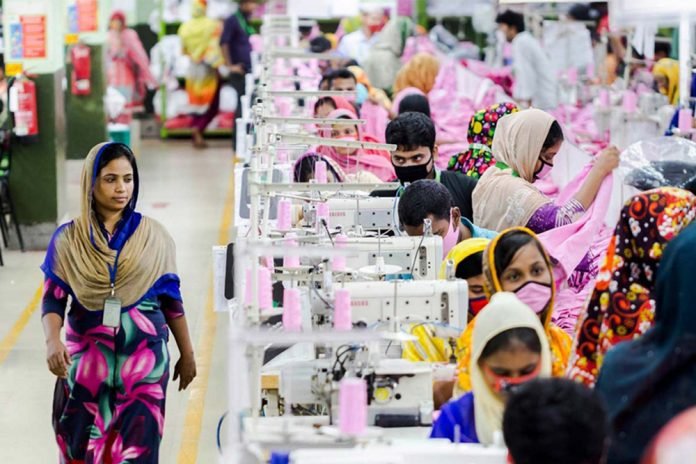Bangladesh’s garment industry has come a long way since its inception, evolving into a key player on the global stage. It has emerged as a significant player in the global garment industry, securing its position as the second-largest garment exporter worldwide. tability.
Experts point out that the roots of Bangladesh’s garment industry can be traced back to the 1970s in the early stages, the industry was primarily focused on meeting domestic demand, with limited international exposure. However, a series of economic reforms and strategic decisions paved the way for Bangladesh to enter the global market.
One of the key factors that propelled Bangladesh’s garment industry onto the global stage is its abundant and cost-effective labour force. The country’s low wage rates attracted international apparel brands and manufacturers seeking to optimise production costs. This competitive advantage allowed Bangladesh to offer affordable clothing to consumers worldwide, fostering sustained demand for its products.
Agreements like the Generalized System of Preferences (GSP) provided the country with tariff advantages in key markets, facilitating increased export volumes. The strategic positioning of Bangladesh in proximity to major consumer markets, such as Europe and North America, also contributed to its accessibility to global supply chains.
The sector has faced criticism and scrutiny over issues such as labour rights, workplace safety, and environmental sustainability. The rapid expansion of the garment industry in Bangladesh has raised concerns about working conditions and labour rights. In response to growing environmental awareness, there is a notable shift towards sustainable practices in the garment industry.
The garment industry is sensitive to global economic fluctuations and uncertainties. Despite the challenges, Bangladesh’s garment industry continues to exhibit resilience and adaptability. The sector’s prospects for future growth are shaped by a combination of factors, including technological advancements, sustainability initiatives, and changing consumer preferences.
The adoption of Industry 4.0 technologies is poised to revolutionise the garment manufacturing process in Bangladesh. Automation, artificial intelligence, and data analytics are being integrated into production systems to enhance efficiency, reduce costs, and improve quality. Embracing these technological advancements will not only boost productivity but also position Bangladesh as a competitive player in the evolving landscape of smart manufacturing.
Bangladesh has started to embrace eco-friendly initiatives, such as using recycled materials, reducing water consumption, and implementing waste management strategies. Adopting fairer manufacturing practices is not only an ethical imperative but also a strategic move to meet the demands of environmentally conscious consumers and comply with international standards.
Consumer preferences are also shifting towards sustainable and ethically produced products. The demand for environmentally friendly and socially responsible fashion is on the rise, and Bangladesh’s garment industry can tap into this trend by aligning its practices with consumer expectations. Sustainable and ethical manufacturing not only attracts conscious consumers but also opens up new market opportunities and strengthens brand loyalty.
In fact, sustainable practices and ethical manufacturing contribute to the resilience of Bangladesh’s garment industry. Addressing labour rights issues and ensuring workplace safety can prevent disruptions due to strikes or accidents. The sector’s prospects for future growth are shaped by a combination of factors, including technological advancements, sustainability initiatives, and changing consumer preferences.
To mitigate risks associated with overreliance on a single sector, Bangladesh’s garment industry is exploring diversification and value addition. Rather than solely focusing on low-cost mass production, manufacturers are venturing into high-value segments, including customised and niche products. This strategic shift allows Bangladesh to cater to diverse market demands and create a more sustainable and resilient industry.
By diversifying product offerings, Bangladesh’s garment industry can tap into niche markets that offer higher profit margins and sustained demand. Customised and specialised garments catered to specific consumer segments can create a competitive edge, allowing manufacturers to differentiate themselves in a crowded global marketplace.
E-commerce has dismantled geographical barriers, allowing Bangladesh’s garment industry to reach a global audience with unprecedented ease. Online platforms provide manufacturers and exporters the opportunity to showcase their products to customers around the world, enabling them to tap into previously untapped markets. This newfound global reach has become instrumental in reducing dependence on traditional brick-and-mortar retail channels. E-commerce platforms empower Bangladesh’s garment industry to adopt a direct-to-consumer (DTC) model, eliminating intermediaries and establishing a more direct connection with end consumers.
E-commerce platforms enable the garment industry to offer customised and personalised products, catering to individual preferences. Through user-friendly interfaces, consumers can personalise garment specifications, choose colours, and select sizes according to their preferences. This level of customisation enhances the overall shopping experience, fostering a sense of individuality and exclusivity.
Despite the positives, challenges lie ahead for Bangladesh’s garment industry. The first of these is sustainability. While this represents an opportunity in some ways, it also is a threat. We are seeing global concerns about clothing over production and mass production centres such as Bangladesh could find themselves in the cross-hairs of these discussions.
Competition is also a challenge. Fast growing rivals such as Vietnam and Turkey are capable of stealing market share from Bangladesh. The latter has the benefit of close proximity to Western customers. The former is ahead of Bangladesh in terms of its technical textile capabilities. Africa is also viewed by many as the next big thing in textile production, although progress in countries such as Ethiopia has been stop-start over the years.
Likewise, talk of near-shoring is an issue Bangladesh should keep a close eye on. There have for many years been discussions around textile near-shoring in countries such as the US and the UK. The benefits of this include speed to market and a reduced environmental footprint.
By addressing the challenges and capitalising on emerging opportunities, Bangladesh’s garment industry can navigate the complexities of a changing world. As the country continues to evolve, the industry’s ability to balance economic growth with social and environmental responsibility will be crucial in shaping its role in the global garment market.



